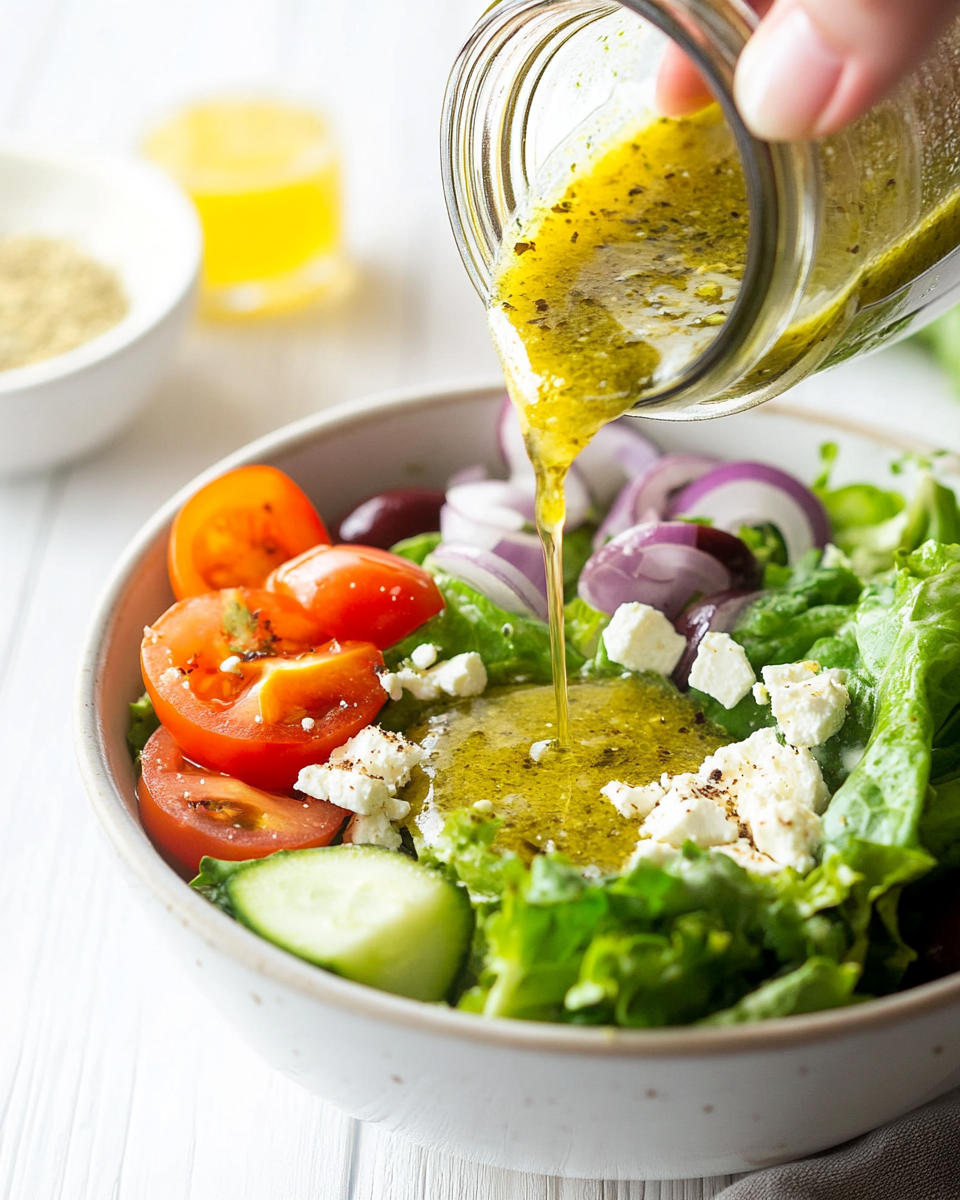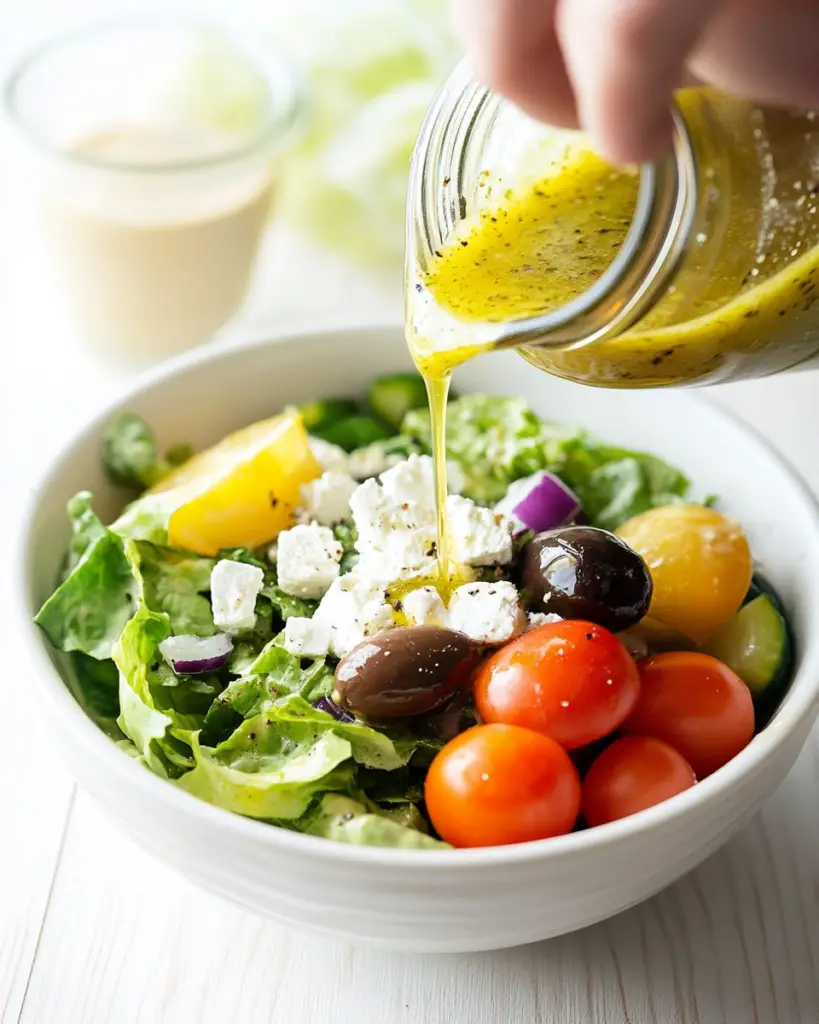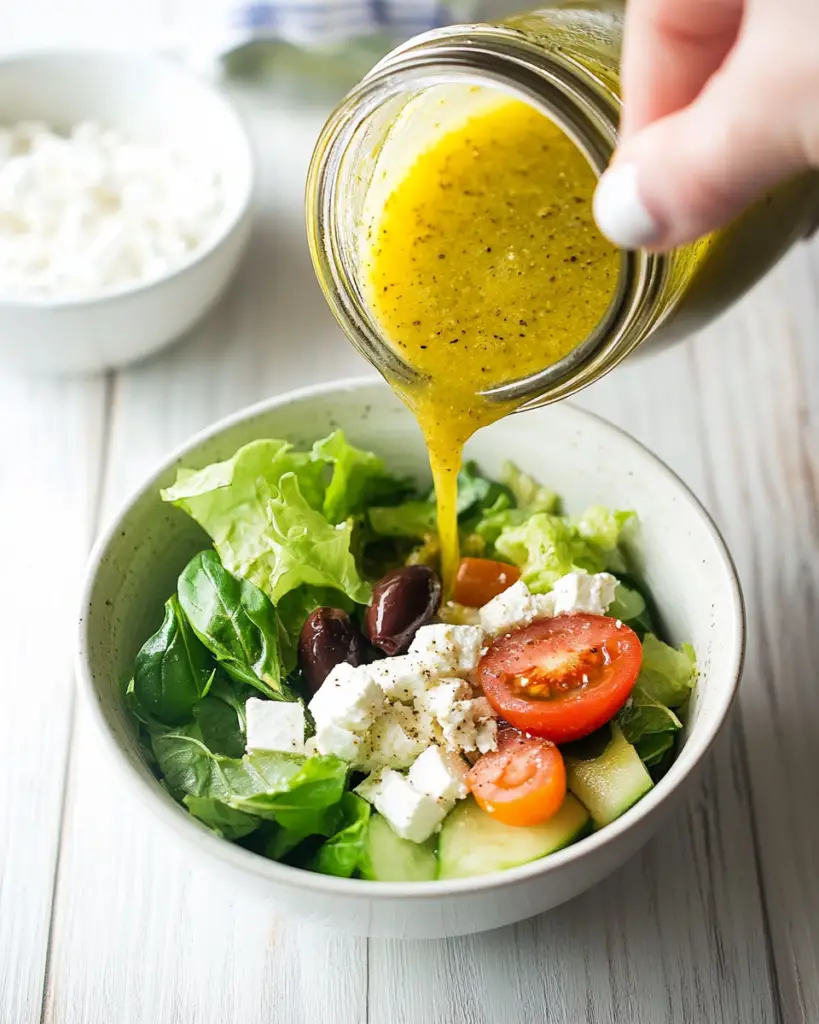The Best Greek Salad Dressing is a bright, bold, and tangy vinaigrette that elevates even the simplest of salads. Made with fresh lemon juice, quality extra-virgin olive oil, oregano, and a touch of Dijon mustard, this homemade dressing brings the taste of the Mediterranean right to your table. With just a handful of pantry staples, it takes five minutes to prepare but delivers complex flavor that far surpasses store-bought options.

Whether you’re tossing it with a traditional Greek salad, using it to marinate grilled meats, or drizzling it over roasted vegetables, this versatile dressing is a staple worth learning. You can also customize it by adding crumbled feta, giving it a creamy, salty twist that complements the tangy base perfectly.
If you’re looking for the best Greek salad dressing that’s easy, fresh, and full of real ingredients, this is it.
Why This Recipe Works
- Quick and Easy – Ready in under five minutes, no cooking required.
- Healthy and Clean – Made with simple ingredients, no preservatives or artificial flavors.
- Flavorful and Versatile – Bright, garlicky, herbaceous, and slightly creamy with optional feta.
- Great as a Marinade – Works beautifully with chicken, shrimp, or grilled vegetables.
- Long Shelf Life – Keeps well in the fridge for up to three weeks.
Preparation Phase and Tools to Use
Before making this dressing, take a moment to gather your ingredients and tools. Since it comes together quickly, preparation makes the process seamless.
Essential Tools and Equipment
- Pint-size mason jar with a lid or any container with a tight seal
- Measuring cups and spoons
- Microplane or fine zester
- Garlic press or sharp knife
Importance of Each Tool
- A mason jar is perfect for emulsifying the dressing—just add everything and shake.
- A microplane ensures fine zest that melts into the dressing, intensifying citrus flavor.
- A garlic press helps achieve a fine mince that distributes evenly.
- Accurate measuring spoons maintain flavor balance.
Preparation Tips
- Use fresh lemon juice for the best flavor. Bottled juice lacks the same brightness.
- Shake the dressing vigorously to emulsify the oil and vinegar fully.
- If adding feta, crumble it finely so it blends evenly.
- Let the dressing sit for 5–10 minutes after mixing. This allows the garlic and oregano to infuse the oil and vinegar.
- Always taste before serving. Adjust salt and pepper as needed based on your salad or dish.
Ingredients List
Here’s what you’ll need for the best Greek salad dressing:
Base Ingredients
- ¾ cup extra-virgin olive oil
- Juice and zest of 1 large lemon (about ¼ cup juice)
- ¼ cup red wine vinegar
- 1 teaspoon Dijon mustard
- 1 teaspoon dried oregano
- 1 clove garlic, minced
- Salt, to taste (about ½ teaspoon)
- Freshly cracked black pepper, to taste (about ¼ teaspoon)
Optional
- ¼ cup crumbled feta cheese
Step-by-Step Directions
Follow these steps to create a perfectly balanced, homemade Greek vinaigrette.
- Combine Ingredients
Add olive oil, lemon juice, lemon zest, red wine vinegar, Dijon mustard, oregano, and minced garlic to a mason jar. - Shake to Emulsify
Seal the jar tightly. Shake vigorously for 20–30 seconds, until the mixture looks well blended and slightly creamy. - Add Feta (Optional)
If using crumbled feta, add it now. Shake again gently to incorporate. - Taste and Adjust
Open the jar, taste the dressing, and adjust salt and pepper as needed. You can also add more lemon juice for brightness or more olive oil for richness. - Serve or Store
Use the dressing immediately, or refrigerate in the sealed jar for up to three weeks. Shake again before each use.
Serving Suggestions for the Best Greek Salad Dressing
The Best Greek Salad Dressing is incredibly versatile. Its bold Mediterranean flavor makes it an ideal addition to a variety of meals—not just salads. Whether you’re hosting a summer barbecue or prepping a quick weekday lunch, this dressing fits into nearly any menu.
Here are several delicious ways to use it:
1. Classic Greek Salad
Drizzle generously over a traditional Greek salad made with chopped cucumbers, juicy tomatoes, red onions, Kalamata olives, and crumbled feta cheese. The dressing ties all the ingredients together with its tangy, garlicky brightness.
2. Grain Bowls
Add a Mediterranean flair to your grain bowls by mixing it with quinoa, farro, or couscous. Top with roasted vegetables, chickpeas, fresh herbs, and a spoonful of hummus for a well-balanced meal.
3. Pasta Salads
Toss it with chilled pasta, cherry tomatoes, sliced black olives, bell peppers, and feta for a quick Greek pasta salad. This is a refreshing option for picnics and meal prep.
4. Marinade for Proteins
Use it as a marinade for chicken, shrimp, or tofu. Its acidity from lemon juice and vinegar helps tenderize proteins while adding robust flavor. Marinate for 30 minutes to 2 hours before grilling or roasting.
5. Roasted Vegetables
Drizzle the dressing over warm, oven-roasted vegetables like zucchini, eggplant, carrots, or Brussels sprouts. The vinaigrette enhances natural sweetness and adds depth with its herbal notes.
6. Sandwiches and Wraps
Use it as a spread alternative or light drizzle in pita wraps or Mediterranean-style sandwiches. It pairs well with grilled chicken, hummus, or falafel.

Common Mistakes to Avoid
While this recipe is simple, a few missteps can dull its flavor or texture. Here’s what to watch for:
1. Using Low-Quality Olive Oil
The flavor of the dressing depends heavily on the olive oil. Choose a high-quality, cold-pressed extra-virgin olive oil. A bland or overly bitter oil will negatively impact the result.
2. Skipping Fresh Lemon Juice
Bottled lemon juice doesn’t have the same acidity or brightness. Always squeeze a fresh lemon and zest it for maximum flavor.
3. Overpowering with Garlic
Garlic is important but strong. Stick to one clove unless you’re a serious garlic lover. Overdoing it can make the dressing bitter and sharp.
4. Not Emulsifying Properly
Without vigorous shaking or whisking, the oil and vinegar will separate quickly. Make sure to shake well before each use to create a creamy, cohesive texture.
5. Forgetting to Adjust for Salt
The dressing’s flavor changes depending on what you serve it with. Always taste and season accordingly, especially if your salad already includes salty ingredients like olives or feta.
6. Using Too Much Dressing
This vinaigrette is bold. Start with a small amount and toss gently before adding more. A well-dressed salad shouldn’t be swimming in dressing.
Side Dish Recommendations
The Best Greek Salad Dressing pairs beautifully with a range of Mediterranean-inspired sides. Here are eight recommendations to round out your meal:
1. Roasted Lemon Potatoes
Crispy on the outside and tender inside, these potatoes soak up the acidity and herbs of the dressing perfectly.
2. Grilled Pita Bread
Lightly charred pita triangles served warm make an excellent dipping companion for extra dressing.
3. Greek Spanakopita
A savory spinach and feta pie wrapped in flaky phyllo dough offers a rich, buttery contrast to the fresh vinaigrette.
4. Lentil Soup with Lemon
Earthy lentils and fresh lemon match the brightness of the dressing, especially in cooler months.
5. Mediterranean Quinoa Salad
Combine quinoa with chickpeas, cucumbers, tomatoes, and fresh parsley, then toss with the dressing for a complete plant-based dish.
6. Stuffed Grape Leaves (Dolmas)
These tangy, herb-filled rice rolls complement the lemony vinaigrette and add a traditional Greek element to your spread.
7. Falafel Patties
Crispy, herbaceous falafel works as a protein-packed side or main and pairs well with the dressing as a dip or drizzle.
8. Hummus and Crudités
Serve with colorful raw vegetables and a generous splash of dressing for extra tang. It’s a light yet satisfying option for lunch or entertaining.

Recipe Tips for the Best Flavor
Here are a few tips to help you perfect this dressing every time:
Use High-Quality Ingredients
Because the recipe uses only a few components, their quality matters. Opt for a good extra-virgin olive oil and fresh, juicy lemons. This will dramatically impact the final flavor.
Let It Rest
Allow the dressing to sit for 10–15 minutes before using. This gives the garlic and oregano time to infuse into the oil and vinegar, deepening the overall flavor profile.
Emulsify Before Each Use
The dressing will naturally separate in storage. Always shake or stir vigorously before drizzling it on salads or using it as a marinade.
Add Fresh Herbs
For added freshness, try incorporating finely chopped parsley or basil. These herbs brighten the flavor and add a subtle aromatic touch.
Make It Vegan
To keep this dressing fully plant-based, simply omit the feta cheese. You can also replace it with a vegan alternative if you want to maintain the creamy texture.
Make It Creamier
For a creamier dressing, blend in a tablespoon of plain Greek yogurt. This transforms it into a slightly thicker dressing, ideal for heartier salads or grain bowls.
Storage and Reheating Instructions
Refrigeration
Store the dressing in an airtight glass jar or bottle in the refrigerator for up to three weeks. Because of the olive oil content, it may solidify slightly when chilled.
Before Using
Remove from the refrigerator and let the dressing sit at room temperature for 10–15 minutes before serving. Alternatively, place the jar in warm water for a few minutes. Avoid microwaving for too long, as overheating will alter the flavor.
Shake Before Serving
Since separation is natural, always shake or stir the dressing well before each use to re-emulsify the ingredients.

Frequently Asked Questions (FAQs)
What is Greek salad dressing made of?
The traditional Greek salad dressing consists of olive oil, lemon juice, red wine vinegar, garlic, oregano, mustard, and salt and pepper. Optional ingredients like feta cheese can be added for extra richness.
Is Greek salad dressing healthy?
Yes, it’s a healthier choice compared to most store-bought dressings. It contains heart-healthy olive oil, antioxidants from lemon and garlic, and no added sugars or preservatives.
Can I use Greek salad dressing as a marinade?
Absolutely. The acidity in the lemon juice and vinegar makes it an excellent marinade for meats, seafood, and vegetables. Marinate proteins for at least 30 minutes to infuse flavor.
How long does homemade Greek salad dressing last?
When stored properly in the refrigerator, this dressing lasts up to three weeks. Make sure the container is tightly sealed to maintain freshness.
Why does the olive oil solidify in the fridge?
Olive oil naturally hardens at cold temperatures. This is normal. Simply let the dressing come to room temperature before using it again.
Can I skip the mustard?
You can, but Dijon mustard helps emulsify the dressing and adds a slight tang. If you omit it, be sure to shake extra well before each use.
How much dressing should I use per salad?
Start with 1–2 tablespoons per serving, then add more to taste. A light coating enhances flavor without overwhelming the ingredients.
Conclusion
This Best Greek Salad Dressing recipe is the kind of kitchen essential you’ll return to again and again. It’s simple, fresh, and filled with the bright, zesty flavors of the Mediterranean. Whether you’re tossing it with crisp vegetables, using it to marinate chicken or shrimp, or adding flavor to grain bowls and wraps, it’s incredibly versatile.
By using fresh ingredients and following the tips shared here, you can make a batch of Greek vinaigrette that not only rivals your favorite restaurant version but also fits a healthy, home-cooked lifestyle. It’s quick to prepare, easy to store, and endlessly useful in both everyday meals and special occasions.
For anyone looking to bring authentic Mediterranean flavor to their kitchen, this recipe delivers.
Best Greek Salad Dressing
Ingredients
- ¾ cup extra-virgin olive oil
- Juice and zest of 1 large lemon about ¼ cup juice
- ¼ cup red wine vinegar
- 1 teaspoon Dijon mustard
- 1 teaspoon dried oregano
- 1 clove garlic minced
- ¼ cup crumbled feta optional
- Salt to taste (about ½ teaspoon)
- Freshly cracked black pepper to taste (about ¼ teaspoon)
Instructions
- In a pint jar or any jar with a tight-fitting lid, combine the olive oil, lemon juice, lemon zest, red wine vinegar, Dijon mustard, oregano, and minced garlic.
- Cover the jar and shake vigorously until the dressing is fully emulsified.
- If using feta, add it to the jar and shake again to mix evenly.
- Taste and season with salt and freshly cracked black pepper, adjusting to your preference.
- Use immediately or store in the refrigerator for up to 3 weeks.






Leave a Comment